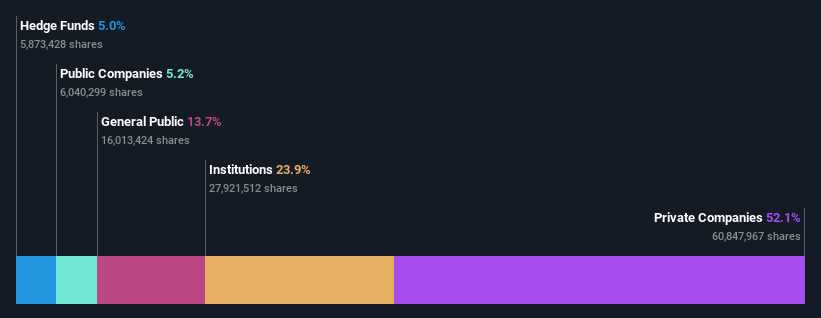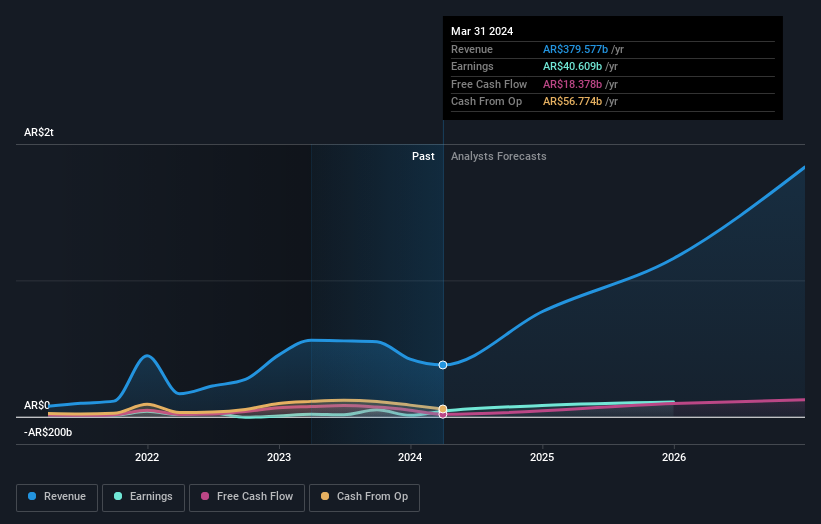Loma Negra Compañía Industrial Argentina Sociedad Anónima's (NYSE:LOMA) top owners are private companies with 52% stake, while 24% is held by institutions
Key Insights
Significant control over Loma Negra Compañía Industrial Argentina Sociedad Anónima by private companies implies that the general public has more power to influence management and governance-related decisions
52% of the company is held by a single shareholder (Participações Morro Vermelho S.A.)
Institutions own 24% of Loma Negra Compañía Industrial Argentina Sociedad Anónima
A look at the shareholders of Loma Negra Compañía Industrial Argentina Sociedad Anónima (NYSE:LOMA) can tell us which group is most powerful. The group holding the most number of shares in the company, around 52% to be precise, is private companies. In other words, the group stands to gain the most (or lose the most) from their investment into the company.
And institutions on the other hand have a 24% ownership in the company. Institutions often own shares in more established companies, while it's not unusual to see insiders own a fair bit of smaller companies.
Let's take a closer look to see what the different types of shareholders can tell us about Loma Negra Compañía Industrial Argentina Sociedad Anónima.
View our latest analysis for Loma Negra Compañía Industrial Argentina Sociedad Anónima
What Does The Institutional Ownership Tell Us About Loma Negra Compañía Industrial Argentina Sociedad Anónima?
Institutions typically measure themselves against a benchmark when reporting to their own investors, so they often become more enthusiastic about a stock once it's included in a major index. We would expect most companies to have some institutions on the register, especially if they are growing.
As you can see, institutional investors have a fair amount of stake in Loma Negra Compañía Industrial Argentina Sociedad Anónima. This implies the analysts working for those institutions have looked at the stock and they like it. But just like anyone else, they could be wrong. If multiple institutions change their view on a stock at the same time, you could see the share price drop fast. It's therefore worth looking at Loma Negra Compañía Industrial Argentina Sociedad Anónima's earnings history below. Of course, the future is what really matters.
It would appear that 5.0% of Loma Negra Compañía Industrial Argentina Sociedad Anónima shares are controlled by hedge funds. That worth noting, since hedge funds are often quite active investors, who may try to influence management. Many want to see value creation (and a higher share price) in the short term or medium term. Participações Morro Vermelho S.A. is currently the largest shareholder, with 52% of shares outstanding. This essentially means that they have extensive influence, if not outright control, over the future of the corporation. In comparison, the second and third largest shareholders hold about 6.6% and 5.3% of the stock.
While it makes sense to study institutional ownership data for a company, it also makes sense to study analyst sentiments to know which way the wind is blowing. There is some analyst coverage of the stock, but it could still become more well known, with time.
Insider Ownership Of Loma Negra Compañía Industrial Argentina Sociedad Anónima
While the precise definition of an insider can be subjective, almost everyone considers board members to be insiders. The company management answer to the board and the latter should represent the interests of shareholders. Notably, sometimes top-level managers are on the board themselves.
Insider ownership is positive when it signals leadership are thinking like the true owners of the company. However, high insider ownership can also give immense power to a small group within the company. This can be negative in some circumstances.
We note our data does not show any board members holding shares, personally. Not all jurisdictions have the same rules around disclosing insider ownership, and it is possible we have missed something, here. So you can click here learn more about the CEO.
General Public Ownership
The general public, who are usually individual investors, hold a 14% stake in Loma Negra Compañía Industrial Argentina Sociedad Anónima. While this size of ownership may not be enough to sway a policy decision in their favour, they can still make a collective impact on company policies.
Private Company Ownership
Our data indicates that Private Companies hold 52%, of the company's shares. It's hard to draw any conclusions from this fact alone, so its worth looking into who owns those private companies. Sometimes insiders or other related parties have an interest in shares in a public company through a separate private company.
Public Company Ownership
It appears to us that public companies own 5.2% of Loma Negra Compañía Industrial Argentina Sociedad Anónima. It's hard to say for sure but this suggests they have entwined business interests. This might be a strategic stake, so it's worth watching this space for changes in ownership.
Next Steps:
It's always worth thinking about the different groups who own shares in a company. But to understand Loma Negra Compañía Industrial Argentina Sociedad Anónima better, we need to consider many other factors. Consider risks, for instance. Every company has them, and we've spotted 1 warning sign for Loma Negra Compañía Industrial Argentina Sociedad Anónima you should know about.
But ultimately it is the future, not the past, that will determine how well the owners of this business will do. Therefore we think it advisable to take a look at this free report showing whether analysts are predicting a brighter future.
NB: Figures in this article are calculated using data from the last twelve months, which refer to the 12-month period ending on the last date of the month the financial statement is dated. This may not be consistent with full year annual report figures.
Have feedback on this article? Concerned about the content? Get in touch with us directly. Alternatively, email editorial-team (at) simplywallst.com.
This article by Simply Wall St is general in nature. We provide commentary based on historical data and analyst forecasts only using an unbiased methodology and our articles are not intended to be financial advice. It does not constitute a recommendation to buy or sell any stock, and does not take account of your objectives, or your financial situation. We aim to bring you long-term focused analysis driven by fundamental data. Note that our analysis may not factor in the latest price-sensitive company announcements or qualitative material. Simply Wall St has no position in any stocks mentioned.
Have feedback on this article? Concerned about the content? Get in touch with us directly. Alternatively, email editorial-team@simplywallst.com

 Yahoo Finance
Yahoo Finance 

